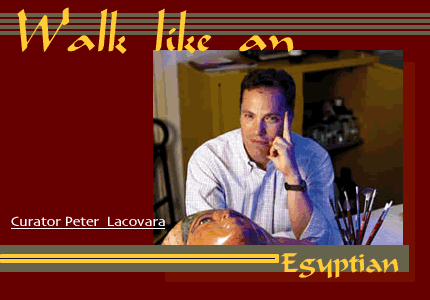|

PETER
LACOVARA is walking along the Nile River, which winds
like an asp along the floor of the first level of Emory’s
Michael C. Carlos Museum, connecting the ancient Greek and Roman
galleries to the new ancient North African galleries.
“One
of the criticisms of the way the galleries were arranged before
was that Egypt was divorced from Africa,” says Lacovara,
Carlos curator and Egyptologist. “Now we are focusing on
Nubia as the joiner between the two cultures.”
Designed
by the museum’s original architect, Michael Graves, the
spacious new earth-toned galleries opened in early October and
showcase ancient Egyptian, Nubian, and Near Eastern pieces.
The impetus for the renovation was the museum’s expanded
Egyptian collection, which includes the 145-item Charlotte Lichirie
Collection of coffins, human and animal mummies, funerary figures,
canopic jars, amulets, jewelry, sculpture, and pottery.
The
antiquities, which date from the twenty-first dynasty (1070-946
B.C.) to the Roman period (31 B.C.-A.D. 395), were purchased
in 1999 from the disbanded Niagara Falls Museum in Ontario for
$2 million, most of which came through donations from the Atlanta
community.
Only
10 to 15 percent of the items, which are part of the Carlos
Museum’s permanent collection, have been displayed here
previously. Additional Ancient Egyptian and Nubian pieces have
been borrowed from the Museum Loan Network, a collaboration
of museums across the country that encourages the sharing of
artifacts. “Many of these are objects from museum basements
that haven’t been seen in decades,” Lacovara says.
A
team led by Carlos Museum conservator Thérèse
O’Gorman spent two years stabilizing and conserving the
ancient Egyptian artifacts. The grand scale of the ancient painted
coffins, many of which are displayed erect around the galleries,
dictated the move to the roomier space.
The
museum’s Egyptian mummies garnered national attention when
experts determined that one of the unwrapped bodies was almost
certainly of royal lineage, and was perhaps even Ramesses I—which
would make it the only pharaonic mummy outside of Egypt. X-rays
and computed tomography scans were taken at Emory Hospital and
DNA tests are being conducted to try to determine its identity.
This mummy is being kept in isolation until tests are complete
but it will be the focus of a special exhibition in the spring
of 2003, Ramesses I: Science and the Search for the Lost Pharoah.
If the mummy is that of Ramesses I, the Carlos Museum has pledged
to return it to Egypt.
Remaining
on view until January 2002 is the The Collector’s Eye:
Masterpieces of Egyptian Art from the Thalassic Collection,
a private collection of more than 175 objects ranging from statues
of pharaohs and their queens to exquisitely crafted amulets,
funerary and cult objects, cosmetic equipment, architectural
elements, royal and private sculpture dating from the Predynastic
Period, around 3500 B.C., to the time of Cleopatra (69-30 B.C.)
The
museum’s Ancient American holdings will move to the former
Egyptian galleries, which will reopen in September 2002.
Museum
Director Anthony Hirschel, who oversaw the acquisition of the
Lichirie collection, has announced that he will be leaving the
Carlos Museum in November after more than four years, to become
the director of the Indianapolis Museum of Art.—M.J.L.
The
Carlos Museum is open Tuesday, Wednesday, Friday, and Saturday
from 10 a.m. to 5 p.m.; Thursday from 10 a.m. to 9 p.m.; and
Sunday from noon to 5 p.m. It is closed Monday and on major
holidays. For more information, go to www.emory.edu/CARLOS.
|